

History - Ancient History in depth: The Anglo-Saxons. What is the influence of Christianity on Anglo-Saxon literature?BROADLY DECRI... The History of English - Old English (c. 500 - c.1100) About 400 Anglo-Saxon texts survive from this era, including many beautiful poems, telling tales of wild battles and heroic journeys.
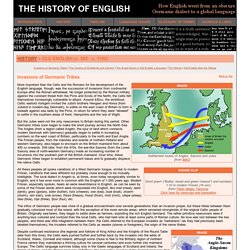
The oldest surviving text of Old English literature is “Cædmon's Hymn”, which was composed between 658 and 680, and the longest was the ongoing “Anglo-Saxon Chronicle”. But by far the best known is the long epic poem “Beowulf”. “Beowulf” may have been written any time between the 8th and the early 11th Century by an unknown author or authors, or, most likely, it was written in the 8th Century and then revised in the 10th or 11th Century. It was probably originally written in Northumbria, although the single manuscript that has come down to us (which dates from around 1000) contains a bewildering mix of Northumbrian, West Saxon and Anglian dialects. The 3,182 lines of the work shows that Old English was already a fully developed poetic language by this time, with a particular emphasis on alliteration and percussive effects. Anglo-Saxon Culture.
The Anglo-Saxons were Germanic barbarians who invaded Britain and took over large parts of the island in the centuries following the withdrawal of the Roman Empire.

They were initially less gentrified than other post-Roman barbarian groups such as the Franks or Ostrogoths because they had less contact with Mediterranean civilization. The Anglo-Saxons were originally pagan in religion. The main group, from northwestern Germany and Denmark, was divided into Angles, Saxons, and Jutes. German tribal affiliations were loose and the original invaders included people from other Germanic groups as well. Anglo-Saxons: a brief history. Publication date: 13th January 2011 King Arthur as one of the Nine Worthies, detail from the 'Christian Heroes Tapestry' This period is traditionally known as the Dark Ages, mainly because written sources for the early years of Saxon invasion are scarce.

It is a time of war, of the breaking up of Roman Britannia into several separate kingdoms, of religious conversion and, after the 790s, of continual battles against a new set of invaders: the Vikings. Climate change had an influence on the movement of these new invaders to Britain: in the centuries after 400 AD Europe's average temperature was 1°C warmer than we have today, and in Britain grapes could be grown as far north as Tyneside. Warmer summers meant better crops and a rise in population in the countries of northern Europe. Anglo-Saxons. Where did the Anglo-Saxons come from? The Anglo-Saxons left their homelands in northern Germany, Denmark and The Netherlands and rowed across the North Sea in wooden boats to Britain.
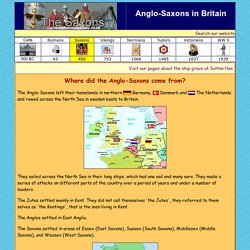
They sailed across the North Sea in their long ships, which had one sail and many oars. They made a series of attacks on different parts of the country over a period of years and under a number of leaders. The Jutes settled mainly in Kent. The Angles settled in East Anglia. The Saxons settled in areas of Essex (East Saxons), Sussex (South Saxons), Middlesex (Middle Saxons), and Wessex (West Saxons). British Kingdoms (each area ruled by a different king) Anglo-Saxon Poetry: Characteristics & Examples.
In this lesson, we will review the general history of Anglo-Saxon society and its era.

Then, we will look closer at the characteristics of the literature, specifically the poetry, of that era. Explore our library of over 10,000 lessons Click "next lesson" whenever you finish a lesson and quiz. Got It You now have full access to our lessons and courses. You're 25% of the way through this course! Way to go! Congratulations on earning a badge for watching 10 videos but you've only scratched the surface. You've just earned a badge for watching 50 different lessons. You have earned a badge for watching 20 minutes of lessons.
You have earned a badge for watching 50 minutes of lessons. You have earned a badge for watching 100 minutes of lessons. You have earned a badge for watching 250 minutes of lessons. You have earned a badge for watching 500 minutes of lessons. Anglo-Saxon. Anglo-Saxon, term used historically to describe any member of the Germanic peoples who, from the 5th century ce to the time of the Norman Conquest (1066), inhabited and ruled territories that are today part of England and Wales.
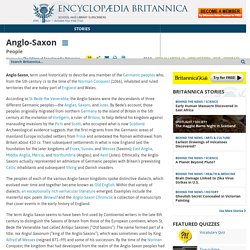
According to St. Bede the Venerable, the Anglo-Saxons were the descendants of three different Germanic peoples—the Angles, Saxons, and Jutes. Anglosaxon Literature and Prose - Beaming Notes. The Germanic forefathers of the English brought with them their own poetry but there is no evidence of them bringing any prose writings.
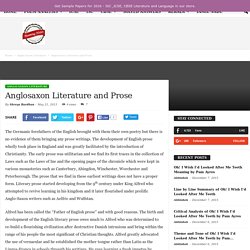
The development of English prose wholly took place in England and was greatly facilitated by the introduction of Christianity. The early prose was utilitarian and we find its first traces in the collection of Laws such as the Laws of Ine and the opening pages of the chronicle which were kept in various monasteries such as Canterbury, Abingdon, Winchester, Worchester and Peterborough. The prose that we find in these earliest writings does not have a proper form. Literary prose started developing from the 9th century under King Alfred who attempted to revive learning in his kingdom and it later flourished under prolific Anglo-Saxon writers such as Aelfric and Wulfstan. ANGLO-SAXON PROSE. In all language ,poetry made its appearance before prose ,and that was also true about Anglo-Saxon prose.Anglo-Saxon prose ,however ,fared much better than its counterpart -Anglo-Saxon poetry .In fact English literary prose came actually as late as nineteenth century under king Alfred's patronization.Anglo-Saxon poetry was archaic and a bit complicated ,but Anglo -Saxon prose was rather comparatively modern and simple.

About Anglo-Saxon prose ,two specific features must be noted at the very beginning .In the very first place it has an essentially has national appearance .In the second place ,it is much closer to modern English than Anglo-Saxon poetry. Aeifric and Wulfstan are the most prominent prose writer of Anglo-Saxon age .Catholic Homilies is famous book of Aeifric.There are a few prose works Blickling Homilies ,a group of nineteenth sermon ,contained in a manuscript ,And some other homilies and fragmentary prose works.
Anglo-Saxon Poetry. The initial page of the Peterborough Chronicle, likely scribed around 1150, is one of the major sources of the Anglo-Saxon Chronicle.
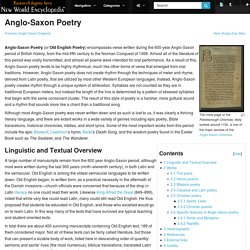
Anglo-Saxon Poetry (or Old English Poetry) encompasses verse written during the 600-year Anglo-Saxon period of British history, from the mid-fifth century to the Norman Conquest of 1066. Almost all of the literature of this period was orally transmitted, and almost all poems were intended for oral performance. As a result of this, Anglo-Saxon poetry tends to be highly rhythmical, much like other forms of verse that emerged from oral traditions.
However, Anglo-Saxon poetry does not create rhythm through the techniques of meter and rhyme, derived from Latin poetry, that are utilized by most other Western European languages. Instead, Anglo-Saxon poetry creates rhythm through a unique system of alliteration. Linguistic and Textual Overview In total there are about 400 surviving manuscripts containing Old English text, 189 of them considered major. Works Credits.